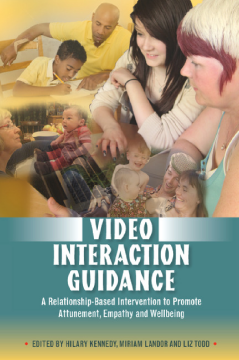
BOOK
Video Interaction Guidance
Katerina Silhánová | Ruth Cave | Rubin Fukkink | Michelle Sancho | Maria Doria | Jacqueline Bristow | Denise McCartan | Henk Vermeulen | Carole S. Chasle | Miriam Landor | Colwyn Trevarthen | Katarina Silhanova | Richard Young | Nelleke Polderman | Jenny Jarvis | Carole Chasle | Calum Strathie | Heather Sked | Mariska Klein Velderman | Maria V. Doria | Sandra Strathie | Ruben Fukkink | Liz Todd | Penny Forsyth | Wilma Barrow | Hilary Kennedy | Angela Roger | Jenny Cross | Deborah James | David Gavine
(2011)
Additional Information
Book Details
Abstract
Video Interaction Guidance (VIG) is an effective intervention which builds positive relationships through filming and feedback sessions. By micro-analysing actions and communications in this way, clients are supported to resolve their current difficulties and increase their sensitivity and attunement within the relationship.
Bringing together contributions from researchers and practitioners across a range of professions, this book provides a definitive introduction to VIG. The book explains the theory behind the approach, reviews research evidence, and offers case studies that document how VIG has been successfully applied to family relationships, schools and higher education, individuals with communication and developmental disorders, and as a reflective professional development tool. The approach is then discussed from a range of theoretical perspectives and within the contexts of narrative therapy, infant and attachment interventions, positive psychology and mindfulness.
This authoritative and comprehensive guide to VIG will be an important text for psychologists, psychiatrists, counsellors, social workers, therapists, and mental health and education professionals, as well as students and academics in these fields.
This excellent book on Video Interaction Guidance, edited by leading experts, should be read by everyone interested in promoting sensitive parent-infant interaction in infancy and supporting vulnerable families. It provides highly accessible descriptions of the approach, its application across a range of settings, and the evidence about its effectiveness. Video Interaction Guidance is undoubtedly an intervention whose time has arrived, and we need wide-ranging groups of practitioners including midwives, health visitors and social workers, to develop the necessary knowledge and skills to intervene with families using this highly effective method of working to bring about change. This book will be an important first step in achieving that.
Professor Jane Barlow, Professor of Public Health in the Early Years, Warwick Medical School, University of Warwick, UK
This is an inspiring book for anyone engaged in working with young children with disabilities and their families, and should serve to broaden the understanding of how powerful this approach can be. However, regardless of our field of work, anyone whose life and work involves interaction and communication with people we care about, including our children, partners, friends and colleagues, might benefit from reading a few chapters from it.
Positive About Autism.
A therapy that promotes interactive attunement between adults and children is taking the world of therapy by surprise. With the help of a simple video camera focusing on the good moments of human interaction, however limited these may be, its practitioners empower their clients, bring a smile to their wary faces and achieve real positive changes in the attachment of their children. Not only is it accessible to all who wish to train under supervision, it is also cost effective and cross-culturally applicable. If you are now curious to know more don't hesitate to buy this exciting new book on Video Interaction Guidance written by eminent practitioners and researchers in what is a promising new development in the therapeutic field of change through mentalisation.
Dr Felicity de Zulueta, Emeritus Consultant Psychiatrist in Psychotherapy at the SLaM NHS Foundation Trust and Honorary Senior Lecturer in Traumatic Studies at King's College London, UK
This is a book of hope. It shows us a way out of the despair of social dysfunction, a way out of continuing with relationship patterns that have become jagged and draining. The contributors to this volume show us repeatedly that, when we are supported to look anew at the way we relate to others, then we come to see both ourselves and our partners in a new light. Joy and growth can be restored to relationships from this reflexive stance. The range of evidence that Kennedy, Landor and Todd have been able to gather together provides a convincing case for Video Interaction Guidance as a therapeutic approach that nurtures lasting behavioural change. It also becomes clear that VIG requires only a modest investment of time or money. The reader begins to feel that VIG is best described not as a method for nurturing behavioural change, but as a method for nurturing compassion.
Dr M. Suzanne Zeedyk, Senior Lecturer in Developmental Psychology, University of Dundee, UK
This book is the first to offer a comprehensive introduction to Video Interaction Guidance (VIG), together with an accessible account of the strands of theory and research underpinning the approach. It provides a much needed resource for both practitioners and trainers in the fields of psychology, social work and education. Particular strengths are the wide range of applications that are described in detail and the illustration provided throughout the book by case studies and session transcript material. Connections with other perspectives and approaches are explored and encouraged in a book that is likely to inspire further development and research in VIG, as well as stimulating interest and engagement more broadly among practitioners.
Professor Norah Frederickson, Director, Educational Psychology Group, Department of Clinical, Educational and Health Psychology, University College London, UK
